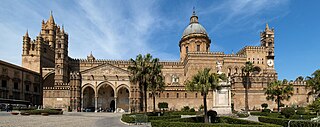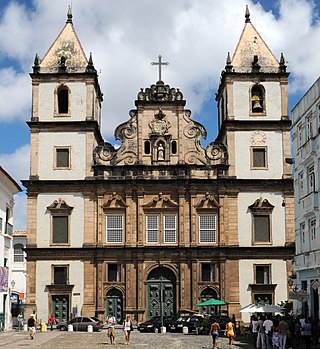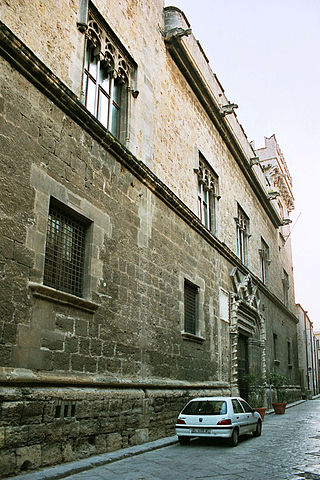Santa Maria della Gancia, also known as Santa Maria degli Angeli, is a 15th-century Roman Catholic church, adjacent to a convent, located on Via Alloro #27 in central Palermo, region of Sicily, Italy.
Contents

Santa Maria della Gancia, also known as Santa Maria degli Angeli, is a 15th-century Roman Catholic church, adjacent to a convent, located on Via Alloro #27 in central Palermo, region of Sicily, Italy.

The name La Gancia derives from an icon of the Child Jesus that was venerated here, supposedly fished from the sea by a monk from the adjacent Convent of the Gancia, which served as a hostel for pilgrims. [1]
The church was commissioned by the Franciscan order beginning in 1490 atop an older church dedicated to St Jerome. The church facade is a hybrid of late Spanish Gothic portal and plain awkward Renaissance windows.
The interior was decorated in the Baroque style. Some of the chapels contain stucco work by Serpotta and a main altarpiece of the Holy Family by Pietro Novelli (he also has works in the 3rd chapel on the left. The second chapel on the right has a painting depicting the Madonna and Saints Catherine and Agata (1528) by Antonello da Palermo. The pilasters of the Presbytery have the Virgin and St Gabriel by Antonello Gagini, who also has works in the 6th chapel on the left. The second chapel on the left has a Nativity by Vincenzo da Pavia. [2]

The church gave the name, Gancia Revolt (Rivolta della Gancia), to a failed 1860 plot against the Bourbon Government. With the aid of some of the Franciscans, some thirty conspirators had hidden themselves in the convent, but were betrayed to the police by one of the friors. On April 4, 1860, troops stormed the convent killing nearly twenty. Thirteen were arrested, but later executed without trial. Two were able to escape by hiding amid corpses in the crypt tombs, and later tunneling out through a small perforation in the wall (buca della salvezza) still marked on Via Allora. [3] A month later, the Expedition of the Thousand by Garibaldi liberated Palermo from Bourbon rule. The 13 men executed were honored with an Obelisk erected at the Piazza delle XIII Vittime at the intersection of Via Cavour and Via Francesco Crispi.

Noto is a city and comune in the Province of Syracuse, Sicily, Italy. It is 32 kilometres (20 mi) southwest of the city of Syracuse at the foot of the Iblean Mountains. It lends its name to the surrounding area Val di Noto. In 2002 Noto and its church were declared a UNESCO World Heritage Site.

Santa Maria della Concezione dei Cappuccini is a Roman Catholic church located at Via Vittorio Veneto, 27, just north of the Piazza Barberini, in Rome, Italy. It is the first Roman church dedicated to the Immaculate Conception.

Santa Maria sopra Minerva is one of the major churches of the Order of Preachers in Rome, Italy. The church's name derives from the fact that the first Christian church structure on the site was built directly over the ruins or foundations of a temple dedicated to the Egyptian goddess Isis, which had been erroneously ascribed to the Greco-Roman goddess Minerva.

Palermo Cathedral is the cathedral church of the Roman Catholic Archdiocese of Palermo, located in Palermo, Sicily, southern Italy. It is dedicated to the Assumption of the Virgin Mary. As an architectural complex, it is characterized by the presence of different styles, due to a long history of additions, alterations and restorations, the last of which occurred in the 18th century.

The Church of St. Mary of the Admiral, also called Martorana, is the seat of the Parish of San Nicolò dei Greci, overlooking the Piazza Bellini, next to the Norman church of San Cataldo, and facing the Baroque church of Santa Caterina in Palermo, Sicily, southern Italy.

The Basilica of Saint Sylvester the First, also known as, is a Roman Catholic minor basilica and titular church in Rome dedicated to Pope Sylvester I. It is located on the Piazza San Silvestro, at the corner of Via del Gambero and the Via della Mercede, and stands adjacent to the central Post Office.

Sant'Anna dei Lombardi,, and also known as Santa Maria di Monte Oliveto, is an ancient church and convent located in piazza Monteoliveto in central Naples, Italy. Across Monteoliveto street from the Fountain in the square is the Renaissance palace of Orsini di Gravina.

The São Francisco Church and Convent of Salvador is located in the historical centre of Salvador, in the State of Bahia, Brazil. The ornate Church of the Third Order of Saint Francis sits adjacent to the convent. The friars of the Franciscan Order arrived in Salvador in 1587 and constructed a convent and church on the site. This structure was destroyed by the Dutch during the Dutch invasions of Bahia in the next century; Father Vicente das Chagas initiated the current structure in 1686, which was completed in the 18th century. The Franciscan church and convent have the largest number of azulejos, 55,000, of any church in Latin America.

Palazzo Abatellis is a palazzo in Palermo, Sicily, southern Italy, located in the Kalsa quarter. It is home to the Galleria Regionale della Sicilia, the Gallery of Art for the Sicilian region.

Santa Maria della Catena is a Roman Catholic church located in the Piazza Dogana, now sandwiched between Strada Statale 113 and Via Vittorio Emanuele, located in the harbor-hugging quarter of Castellammare in Palermo, region of Sicily, Italy.

The Basilica of Santa Maria Assunta is a 14th-century basilica in Alcamo, province of Trapani, Sicily, southern Italy. It is named after the Assumption.

The Church of Our Lady of the Graces is a Gothic-style, Roman Catholic church in Varallo Sesia, province of Vercelli, region of Piedmont, Italy. The church was built, together with the adjacent Franciscan convent, by padre Bernardo Caimi between 1486 and 1493. At this time, the construction of the Sacro Monte was also beginning. In December 1931, Pope Pius XI gave the church the title of Minor Basilica.

The Church of Saint Francis of Assisi is a Gothic-style, Roman Catholic church of Palermo. It is located near a major and ancient street of the city, via Cassaro, in the quarter of the Kalsa, within the historic centre of Palermo. The building represents the main Conventual Franciscan church of Sicily, and has the title of minor basilica.

Santa Caterina d'Alessandria or Saint Catherine of Alexandria is a Roman Catholic church with a main facade on Piazza Bellini, and a lateral Western facade facing the elaborate Fontana Pretoria, in the historic quarter of Kalsa in the city of Palermo, region of Sicily, Italy. In front of the main facade, across the piazza Bellini, rise the older churches of San Cataldo and Santa Maria dell'Ammiraglio, while across Piazza Pretoria is the Theatine church of San Giuseppe and the entrance to the Quattro Canti. Refurbished over the centuries, the church retains elements and decorations from the Renaissance, Baroque, and late-Baroque (Rococo) eras. This church is distinct from the Oratorio di Santa Caterina found in the Olivella neighborhood.

Santa Maria di Gesù (Italian) is a Baroque Catholic parish church in the Palermo region of Sicily, Italy. It faces the Beati Paoli plaza in the Capo quarter.

Santa Maria dei Miracoli (English: Holy Mary of the Miracles is a Renaissance-style, Roman Catholic church located in the quarter of Kalsa of the historic centre of Palermo, region of Sicily, Italy. It is located in front of the Giardini Garibaldini and Piazza Marina.

San Nicola da Tolentino, or more in non-dialect known as the church Saint Niccolò da Tolentino, is a Roman Catholic church located on via Maqueda #157, between via dei Calderai and via Giardinaccio, at the Southwest border of the quarter of Kalsa (Tribunali) of the historic centre of Palermo, region of Sicily, Italy.

The Obelisk for the 13 Victims of 14 April 1860 is a monument honoring the thirteen prisoners executed, without trial, for conspiring to lead a revolt against the Bourbon monarchy. It is located in a park, the Piazza delle XIII Vittime, at the intersection of Via Cavour and Via Francesco Crispi, just north of the church of San Giorgio dei Genovesi in the ancient quarter of Castellammare of Palermo, region of Sicily, Italy.

Madonna dei Rimedi is a Baroque-style, Roman Catholic Sanctuary-church, established and still affiliated with the Discalced Carmelite order, located on Piazza Indipendenza # 9, in Palermo, region of Sicily, Italy.

The New Archaeological Museum is an Italian civic museum set up in the former convent of Santa Maria della Pietà of the Observant Friars Minor, in Ugento in the province of Lecce.